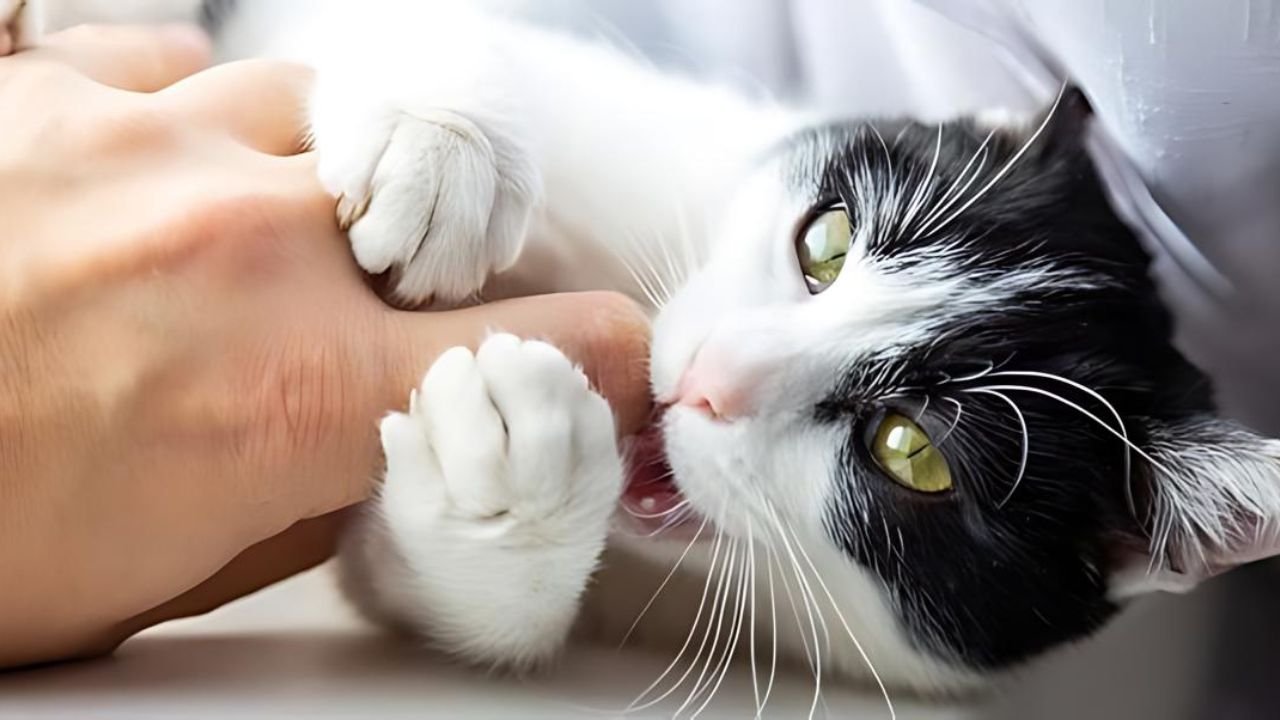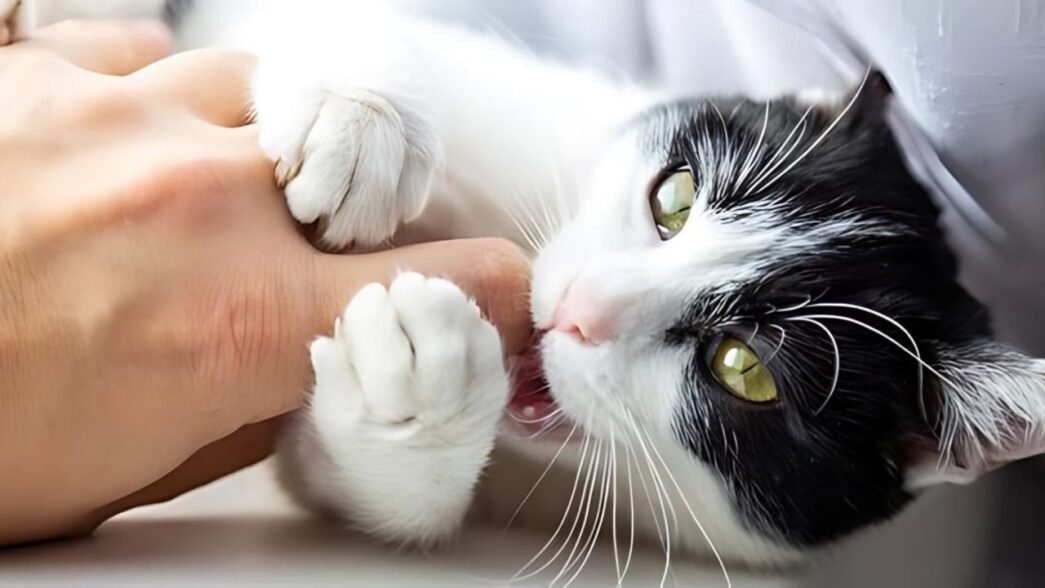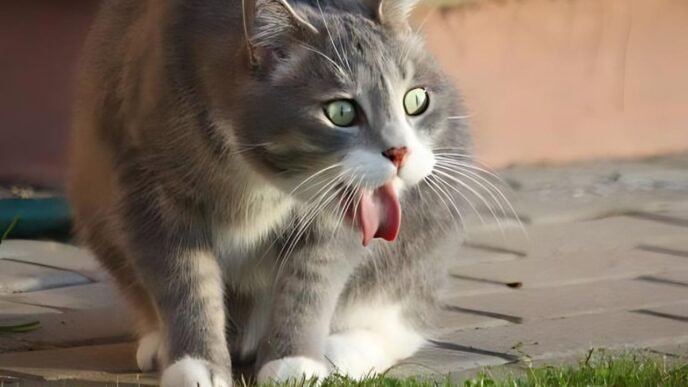Why Does My Cat Gently Bite Me? This puzzling yet common behavior leaves many cat owners scratching their heads. Often accompanying moments of affection or playfulness, these gentle nibbles can carry various meanings. From showing love to signaling overstimulation, it’s essential to decipher what your feline friend is trying to communicate. Understanding why your cat gently bites you can deepen your bond and ensure harmonious interactions. Let’s explore the intriguing reasons behind this behavior.
01. Understanding Gentle Biting in Cats
Cats are fascinating creatures with unique behaviors. One of the perplexing yet common actions you might notice is gentle biting. This type of biting often happens when you’re playing or petting them and can vary in meaning based on context.
01. What is Gentle Biting?
Gentle biting, also known as “love bites,” is when your cat softly nibbles on your skin without causing pain. These nibbles are typically light and painless, almost like a gentle pinch. It’s important to understand that this behavior is a normal part of how cats communicate. Here’s what it often looks like:
- The bite feels more like a mild pressure or tickle.
- There’s usually no breaking of skin or intense pain.
- It can be a brief action, followed by licking or grooming.
Some reasons why gentle biting occurs:
- Affection: Just like cats groom each other with little nibbles, they might do the same to you to show love (source: Applaws US).
- Playfulness: During a playful session, your cat might get carried away and give you a soft bite.
- Attention-seeking: Sometimes, a gentle bite is your cat’s way of saying, “Hey, pay attention to me!”
02. Differentiating Gentle vs. Aggressive Biting
Not all bites are the same. Recognizing the difference between gentle and aggressive biting can help you respond appropriately and maintain a good relationship with your furry friend.
Key Differences:
- Body Language: Always look at your cat’s body language to gauge their mood. A cat that gently bites typically has a relaxed posture, with purring or soft meows. An aggressive bite, however, often comes with hissing, growling, or a puffed-up body (source: PetMD).
- Context of Interaction: Gentle bites happen during positive interactions like playing or petting. If your cat bites you to assert dominance or out of fear, it’s usually more forceful and comes out of a stressful situation (The Vets).
Watch for these signs of gentle biting:
- Soft, repetitive nibbles
- Positive body language: Ears forward, tail relaxed, eyes half-closed
- Accompanied by purring or playful behavior
Signs of aggressive biting:
- Forceful and hard bites
- Negative body language: Ears flattened, tail thrashing, eyes wide-open
- Hissing, growling, swatting
Understanding the subtle nuances of your cat’s behavior can strengthen your bond and ensure peaceful, loving interactions. By paying attention to gentle versus aggressive biting, you can better meet your cat’s needs and enjoy more harmonious, playful moments together.
02. Reasons Why Cats Gently Bite
Understanding why cats gently bite can help you appreciate their unique ways of communicating. It’s more than just a nibble—it reveals much about their feelings and needs.
01. Affection and Bonding
Cats often gently bite as a form of affection and bonding. These “love bites” are a feline way of showing they care, similar to how they might groom each other.
- Love Bites: Just like social grooming, love bites are soft and gentle. Cats use them to connect and show they trust you.
- Social Grooming: When a cat grooms another, the gentle nibbles are a part of the process. They see you as part of their family and extend this behavior to you (Applaws US).
02. Overstimulation
Cats have a limit to how much physical interaction they can handle. When petting or cuddling becomes too much, a gentle bite can be their way of saying it’s time to stop.
- Signs of Overstimulation: Watch for twitching tails, flattened ears, and dilated pupils. These signals accompany gentle bites indicating they’re overstimulated.
- Recognizing Overstimulation: Understanding your cat’s threshold can prevent these bites. They’re simply communicating they need a break (The Vets).
03. Playfulness
Gentle biting is also a common sign of playfulness. Cats, especially kittens, learn to hunt and play through biting.
- Learning Through Play: Young cats learn coordination and hunting skills by play-biting their siblings. This playful behavior extends to interactions with you.
- Reinforcing Playfulness: It’s important to differentiate between play bites and aggressive bites. Gentle, painless nibbles are typically playful whereas harder bites may indicate something else (PetMD).
04. Attention-Seeking Behavior
When your cat wants your attention, they might resort to gentle biting. This behavior often occurs when they want pets, food, or simply your company.
- Examples of Attention-Seeking: Your cat might gently bite your hand to get petted or nip at your toes to remind you it’s mealtime. They use these soft bites to communicate their needs.
- Understanding the Bites: Recognizing this behavior helps you address your cat’s needs promptly, leading to a happier and more affectionate pet (USA Today).
05. Grooming Instincts
Gentle biting fits within a cat’s grooming habits. When they groom themselves or each other, they often use their teeth to remove loose fur and dirt.
- Mother Cat Grooming: Mother cats groom their kittens using their teeth for thorough cleaning. When your cat gently bites you, they may be extending this nurturing instinct.
- Self-Grooming and You: Cats see their humans as extensions of their own family and might include you in their grooming routines (Quora).
Understanding why cats gently bite is key to strengthening your bond with them. Each bite is a window into their world, offering insights into their emotions and needs. With patience and observation, these gentle nibbles can enhance your connection.
03. How to Respond to Gentle Biting
Understanding and appropriately responding to your cat’s gentle biting can ensure it remains a positive interaction. Let’s explore how to handle this behavior in a way that strengthens your bond with your furry friend.
01. Positive Reinforcement
Using positive reinforcement can help encourage desired behaviors and discourage biting. Here are some effective strategies:
- Reward Good Behavior: Whenever your cat plays gently without biting, reward them with treats or affection. This reinforces the idea that gentle playtime is positive.
- Distract with Toys: Provide toys to redirect their biting tendencies. Using interactive toys can channel their energy and keep their attention away from your hands.
- Consistency is Key: Be consistent with rewards. Every time your cat interacts gently, make sure they receive a positive response from you.
Positive reinforcement helps teach your cat what behaviors are acceptable, making playtime more enjoyable for both of you (The Vets).
02. Setting Boundaries
Setting clear boundaries can prevent overstimulation and undesired biting during play. Here’s how to do it effectively:
- Recognize Early Signs: Pay attention to signs of overstimulation, such as twitching tails or flattened ears. These signals indicate your cat might need a break.
- Create Safe Spaces: Ensure your cat has a quiet area to retreat to if they become overstimulated. This space should be free from excessive noise and distractions.
- Limit Play Sessions: Keep play sessions short and varied. Instead of long periods of play, opt for multiple short sessions throughout the day.
By setting boundaries, you help your cat feel secure and reduce the likelihood of biting due to overstimulation (The Spruce Pets).
03. Understanding Your Cat’s Signals
Understanding and recognizing your cat’s body language is crucial. Knowing what your cat is trying to communicate can improve your interactions immensely:
- Relaxed Posture: A cat with a relaxed posture, half-closed eyes, and a softly waving tail is generally happy and content.
- Ears and Tail Position: Ears pointing forward and a relaxed tail indicate a positive mood. In contrast, flattened ears and a thrashing tail suggest irritation or overstimulation.
- Purring vs. Growling: Purring usually means satisfaction, while growling or hissing indicates the opposite.
By learning to read these signals, you can better understand when your cat is content versus when they need space (PetMD).
Implementing these strategies can enhance your bond with your cat while keeping playtime safe and enjoyable. Understanding their signals and responding appropriately can turn those gentle bites into positive, loving interactions.
04. When Gentle Biting Becomes a Problem
While gentle biting is usually harmless and can be a sign of affection or playfulness, there are times when it becomes a concern. Understanding when and why this transition happens is crucial for every cat owner. Let’s examine what to do if your cat’s behavior starts to escalate.
01. Escalating Aggression
Occasionally, gentle biting may escalate into more aggressive behavior. If your cat’s soft nibbles turn into painful bites, it’s essential to understand the underlying cause and respond appropriately.
How to Manage Escalating Aggression:
- Observe Body Language: Pay close attention to your cat’s body language. Are their ears flattened? Is their tail twitching aggressively? These signs can indicate that your cat is agitated.
- Interrupt the Behavior: If your cat begins to bite harder, immediately stop any interaction. Gently move your hand away and avoid further physical contact until they calm down.
- Use Positive Reinforcement: Reward your cat for gentle behavior with treats or affection. If your cat only uses gentle nibbles, positively reinforce this by providing a small treat.
- Redirect Attention: Engage your cat with toys to divert their energy away from biting you. Interactive toys, such as feather wands or laser pointers, can be excellent for this purpose.
- Establish Boundaries: If biting during play is common, set clear boundaries. End the play session if biting becomes too harsh and resume only when your cat is relaxed.
Ignoring signs of building aggression can lead to more severe biting habits. Proactively addressing it ensures a safer and less problematic interaction. For more on handling aggressive biting in pets, see ASPCA’s guidelines.
02. Health Concerns
Changes in your cat’s biting behavior could sometimes indicate underlying health issues. If a typically gentle cat suddenly becomes aggressive when biting, it may be due to discomfort or pain.
Possible Health Issues:
- Dental Problems: Cats with dental issues might bite more aggressively due to pain in their mouth. Regular dental check-ups can help prevent problems.
- Arthritis or Joint Pain: Older cats might experience pain from arthritis, making them more irritable and prone to biting.
- Skin Conditions: Issues such as flea infestations or allergies can make a cat’s skin sensitive, leading to more defensive biting behaviors.
- Infections or Injuries: An unnoticed injury or infection could also make a cat more prone to sudden aggressive biting.
Importance of Consulting a Veterinarian: If you observe significant changes in your cat’s biting behavior, consulting a veterinarian is crucial. They can help identify any health issues that may be causing discomfort or pain. Regular vet visits ensure your cat remains healthy and any problems are detected early on (Applaws).
Health problems can often go unnoticed, leading to changes in behavior such as increased aggression. Keeping tabs on your cat’s health and seeking professional advice when needed will help maintain their overall well-being and prevent problematic biting.
In summary, while gentle biting is usually normal, staying vigilant about its escalation and any underlying health issues helps ensure the safety and happiness of your furry companion.
05. Top 5 Amazon Products to Enhance Your Cat-Parent Bond
1. Petstages Dental Health Cat Chew Toys: These dental chew toys not only entertain your cat but also promote dental health, which can reduce biting due to dental issues.
2. SmartyKat Feather Whirl Electronic Motion Cat Toy: Encourage playful biting and direct your cat’s energy towards a fun toy. This interactive toy is perfect for stimulating your cat’s hunting instincts.
3. Feliway Classic Calming Diffuser Kit: Help mitigate stress and overstimulation in your cat with this calming diffuser, which creates a peaceful environment and reduces biting incidents.
4. Burt’s Bees for Cats Natural Dander Reducing Wipes: Regular grooming with these natural wipes can keep your cat’s skin healthy and decrease discomfort that might lead to biting.
5. Wellness CORE Grain-Free Canned Cat Food: Ensure your cat is in top health with high-quality nutrition, potentially reducing health-related irritation and biting behavior.
These products not only address various aspects of your cat’s well-being but also encourage positive behaviors, creating a happier and healthier relationship between you and your furry friend.
06. Frequently Asked Questions
1. What are some specific signs that indicate my cat’s gentle biting is a show of affection?
Cats often show affection through gentle biting, sometimes referred to as “love bites.” Specific signs include:
- Relaxed Body Posture: Your cat’s body will be relaxed, with no signs of tension or aggression.
- Soft Purring and Meowing: Accompanying gentle bites with soft purring or meowing indicates contentment.
- Licking: Following a bite with licking is a grooming behavior showing affection.
- Slow Blinking: If your cat gently bites you and then slow blinks, it’s a sign they trust and love you.
2. How can I tell if my cat’s gentle bite is due to overstimulation during petting or play?
Overstimulation can cause gentle biting. Look for these signs:
- Twitching Tail: A tail flicking or twitching signals irritation.
- Flattened Ears: Ears going back or flattening against their head indicate discomfort.
- Dilated Pupils: Enlarged pupils can be a sign of stress or excitement.
- Rapid Movements: Sudden changes in body movement can show your cat is becoming overstimulated.
If you notice these signs, it’s a cue to stop petting or playing to avoid escalating into harder bites.
3. What body language cues should I look for to differentiate between gentle and aggressive biting?
Body language is key in distinguishing between gentle and aggressive bites:
Gentle Biting:
- Relaxed Posture: Body and muscles are relaxed.
- Forward Ears: Ears are usually pointing forward or in a neutral position.
- Soft Eyes: Eyes may be half-closed or slowly blinking.
- Soft Purring: Indicates contentment and comfort.
Aggressive Biting:
- Tense Body: Muscles are tense, ready to pounce or defend.
- Flattened Ears: Ears are back, flat against the head.
- Wide Eyes: Eyes are wide open, with dilated pupils.
- Hissing/Growling: Verbal warnings of discomfort or aggression.
4. Are there any health issues that might cause my cat to start gently biting more frequently?
Yes, several health issues could lead to increased gentle biting:
- Dental Problems: Issues like gingivitis or abscesses can cause discomfort, leading to biting as a response.
- Arthritis or Joint Pain: Older cats with arthritis might bite to communicate pain.
- Skin Irritations: Conditions like fleas, allergies, or dermatitis cause itching and discomfort.
- Infections or Injuries: An unnoticed wound or infection might make a cat more sensitive and likely to bite.
Regular vet check-ups can help detect and address these health concerns early.
5. What steps can I take to positively reinforce gentle behavior and discourage more forceful biting?
Positive reinforcement can encourage gentle behavior. Here’s how:
- Reward Gentle Behavior: Always reward your cat with treats or affection when they interact gently.
- Use Toys for Play: Redirect biting to toys rather than hands. Interactive toys like feather wands or laser pointers are excellent options.
- Consistency: Be consistent with your rewards and corrections. If they behave gently, reward them every time.
- Set Boundaries: Stop play or petting sessions if biting becomes too rough. Resume only when your cat is calm and relaxed.
- Positive Reinforcement: Use treats and positive reinforcement techniques to guide your cat towards gentle behavior.
By understanding and responding to your cat’s behavior, you can foster a loving and playful relationship.
Read more: Why Are Orange Cats So Dumb? Shocking Truths Revealed
07. Conclusion – Why Does My Cat Gently Bite Me?
Understanding why your cat gently bites you enriches the bond you share. These soft nibbles are often affectionate, playful, or mild requests to stop overdoing physical interaction.
Recognize the context of the bite and your cat’s body language to interpret their needs. Gentle biting is typically harmless and just another way your cat communicates with you. Emphasize positive reinforcement, set clear boundaries, and pay attention to their signals to foster a loving and playful relationship with your feline friend.













